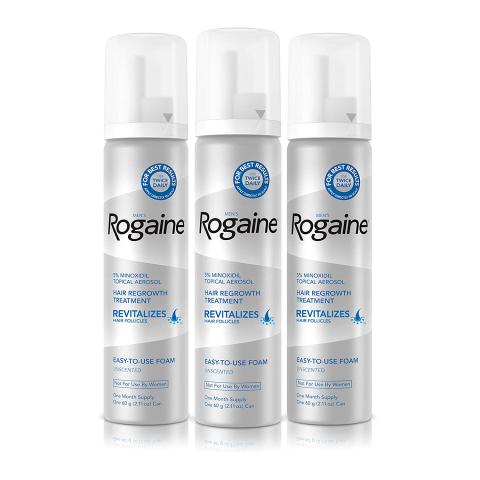
What is Rogaine?
Along with Propecia, Rogaine is one of only two drugs approved by the FDA for treating hair loss.
Minoxidil, (Rogaine’s active ingredient), was originally created as a drug for treating hypertension (high blood pressure). It was then discovered that one of its side affects was growing hair. Minoxidil was then tested for use as a topical application for regrowing hair. The results were sufficiently impressive that the FDA approved it as a treatment for hair loss.
How Rogaine works.
Rogaine works by revitalizing shrunken hair follicles, thus increasing their size. When you use Rogaine every day, your follicles may increase in size, and the growing phase may become longer. This may then produce longer, thicker hairs.
Rogaine is a clear alcohol-based solution and should be applied to a person’s thinning area with its supplied dropper or spray twice a day.
The solution is approved and available in two strengths -- Regular (2%) and Extra Strength (5%). Individual users of regular strength Rogaine have claimed success rates of 30-40%. Meanwhile, users of Extra Strength Rogaine have claimed success rates of 50-60%. Currently, the average price for a 2oz. bottle of Rogaine is about $20-30 per month. Minoxidil is also available as a generic and can be purchased over the counter without prescription.
It’s important to note that Rogaine (minoxidil) does not cure baldness and scientists have been unable to determine just how it works. What is known is that Rogaine increases the blood flow to the areas of the scalp that surround these balding areas. Currently some researchers believe that Rogaine (minoxidil) works by opening the follicle’s potassium channels located in the cells. It’s theorized that these channels, when opened, may regulate hair growth.
Rogaine can’t grow hair on completely bald scalps or in the frontal hairline areas. It has been found to be somewhat effective in maintaining or growing hair in the crown area (the top back of the head). However, Rogaine is only effective at delaying hair loss. It is also more effective in women than in men. And again, the reasons for this are not understood.
What can I expect with Rogaine?
Rogaine (minoxidil) generally only regrows hair in a minority of men and women. In most cases, the best case scenario for hair growth with these treatments is a thin coverage of thin hair.
The real benefits of Rogaine (minoxidil) is keeping what hair you have or slowing your thinning. Rogaine’s success depends on how advanced your hair loss has become.
You must apply it to your scalp twice a day for life to get and maintain any benefits. Research shows that using Rogaine (minoxidil) only once a day is ineffective. If you stop taking Rogaine (minoxidil) you will lose whatever hair you preserved or regrew within 2 to 4 months. And while Rogaine may stimulate hair growth, it may not prevent the hair follicles from their eventual deterioration.
It’s also true that Rogaine’s effects may diminish over time. Some doctors believe that patients can build up a tolerance after many years of use.
Are there side effects from Rogaine?
There are only minor side effects with Rogaine. But some users do experience certain problems such as scalp irritation, itching, and dandruff. However, this can be treated with a good shampoo like Nizoral or Neutrogena T-Gel. There may also be an increase in hair shedding at the start of the treatment. You shouldn’t panic, as this may actually be a signal that the treatment is working.
Due to the medication’s alcohol content, some users may develop a contact rash or irritated skin. And with excessive doses, some users may experience dizziness or a rapid heartbeat. However, with normal use these effects are uncommon.
Rogaine users with severe, refractory high blood pressure experienced some problems. One such problem was “hypertrichosis,” hair growth on the face or other bodily areas. This side effect appears in about 3-5 % of women who use the 2% solution, and higher among women using the 5% solution.
Rogaine and Hair Transplants.
Some hair restoration physicians have come to consider Rogaine to be instrumental right after surgery. This is especially true when grafts have been placed in and around existing hair.
The shock of surgery can result in temporary hair loss. Rogaine is thought to possibly help prevent this temporary loss of healthy preexisting hair. The 5% solution has been found to be more effective for men and women. However, some physicians believe that the medication should be stopped a week or two before surgery. They feel that Rogaine may increase bleeding, while dilating blood vessels.








